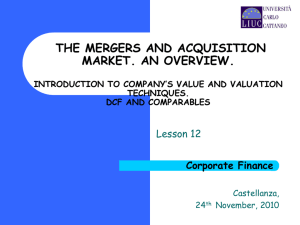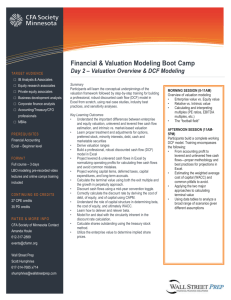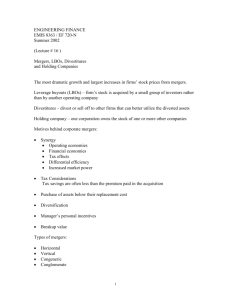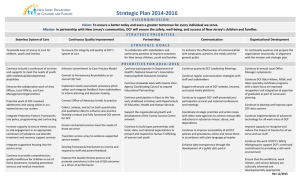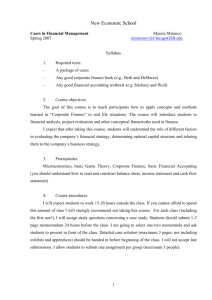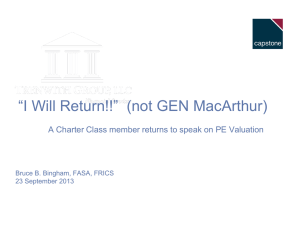Week 2 Objectives - marshall inside . usc .edu
advertisement
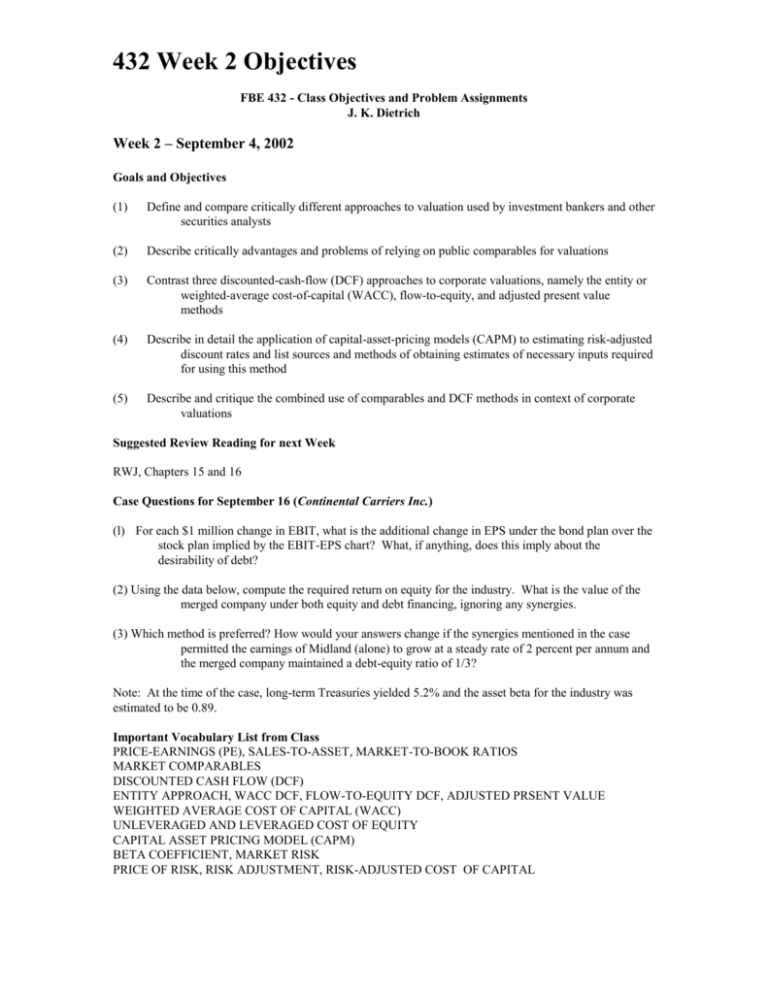
432 Week 2 Objectives FBE 432 - Class Objectives and Problem Assignments J. K. Dietrich Week 2 – September 4, 2002 Goals and Objectives (1) Define and compare critically different approaches to valuation used by investment bankers and other securities analysts (2) Describe critically advantages and problems of relying on public comparables for valuations (3) Contrast three discounted-cash-flow (DCF) approaches to corporate valuations, namely the entity or weighted-average cost-of-capital (WACC), flow-to-equity, and adjusted present value methods (4) Describe in detail the application of capital-asset-pricing models (CAPM) to estimating risk-adjusted discount rates and list sources and methods of obtaining estimates of necessary inputs required for using this method (5) Describe and critique the combined use of comparables and DCF methods in context of corporate valuations Suggested Review Reading for next Week RWJ, Chapters 15 and 16 Case Questions for September 16 (Continental Carriers Inc.) (l) For each $1 million change in EBIT, what is the additional change in EPS under the bond plan over the stock plan implied by the EBIT-EPS chart? What, if anything, does this imply about the desirability of debt? (2) Using the data below, compute the required return on equity for the industry. What is the value of the merged company under both equity and debt financing, ignoring any synergies. (3) Which method is preferred? How would your answers change if the synergies mentioned in the case permitted the earnings of Midland (alone) to grow at a steady rate of 2 percent per annum and the merged company maintained a debt-equity ratio of 1/3? Note: At the time of the case, long-term Treasuries yielded 5.2% and the asset beta for the industry was estimated to be 0.89. Important Vocabulary List from Class PRICE-EARNINGS (PE), SALES-TO-ASSET, MARKET-TO-BOOK RATIOS MARKET COMPARABLES DISCOUNTED CASH FLOW (DCF) ENTITY APPROACH, WACC DCF, FLOW-TO-EQUITY DCF, ADJUSTED PRSENT VALUE WEIGHTED AVERAGE COST OF CAPITAL (WACC) UNLEVERAGED AND LEVERAGED COST OF EQUITY CAPITAL ASSET PRICING MODEL (CAPM) BETA COEFFICIENT, MARKET RISK PRICE OF RISK, RISK ADJUSTMENT, RISK-ADJUSTED COST OF CAPITAL 432 Week 2 Objectives Suggested Wall Street Journal (WSJ) or other Articles August 26, 2002 “Full Speed Ahead: How Enron Bosses Created a Culture of Pushing Limits” (A1) and “Justice Department Finds Building Criminal Case Against Lay Tough” (A3) – Stories illustrating problems in corporate governance at Enron and details conflicts of interest with Fastow “Hedge Funds Grew Madly – Now, the Shakeout” (C1) – Two stories (“Startups Are Suffering As Performance Fades, Investors Grow Wary” and “Cooperman Sustains a ‘Difficult’ Year Amid Market Woes” provide good background into hedge fund industry and how it works August 27, 2002 “Bankruptcy Bill Eases Conflict Curbs” (C1) and “Salomon Says It sent Hot IPOs WorldCom’s Way” (C1) – Stories outline role of investment banks in bankruptcy proceedings in discussion change in laws and illustrate eagerness with which investment bankers pursue potential clients (expands on discussion of investment banking discussed last week) “Private-Equity Firms Court Energy Industry” (C1) – Discussion of large pools of private equity investor and describes one current investment strategy (we will discuss private equity investors when discussing venture capital) August 28, 2002 “Salomon Made IP Allocations Available to Ebbers, Others” (A1) – Details on pressures on investment bankers to develop business prospects and ways the did this “Mergers Snapshot/Food Products” (C4) – Graphs illustrates mergers in food products companies and illustrates tracking of various segments of financial industry (we analyze two food companies, Eskimo Pie and in “Hunt for Red October”) August 29, 2002 “U.S., Pushing WorldCom Case, Indicts Ex-CFO and His Aide” (A1) – Discusses some of the reasons for prosecuting executives involved in a corporate collapse August 30, 2002 “Nestle Says a Takeover of Hershy Wouldn’t Pass Antitrust Muster” (A1) – Illustrates some issues involved with sale of a company and a major acquisition and an example of mergers and acquisitions we will discuss this semester “Marconi to Focus on Key Markets In Strategy Shift” (B2) – Firm changes marketing strategy due to debt burder illustrating relation between financing and business strategy we discuss in a case later this semester “Vlasic Creditors Claim Campbell Lied About Spinoff” (B5) – Spinoff (like the Eskimo Pie case) produces problems for the firm and its creditors

